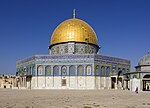Mar Saba
| History of Palestine |
|---|
 |
|
|
31°42′18″N 35°19′52″E / 31.705°N 35.331°E



The Holy Lavra of Saint Sabbas the Sanctified,[1] known in Arabic as Mar Saba (Template:Lang-ar; Template:Lang-he; Template:Lang-el), is a Greek Orthodox monastery overlooking the Kidron Valley[2] in Bethlehem Governorate of Palestine. The traditional date for the founding of the monastery by Sabbas the Sanctified of Mutalaska, Cappadocia is the year 483[3] and today houses around 20 monks. It is considered to be one of the oldest inhabited monasteries in the world, and still maintains many of its ancient traditions. One in particular is the restriction on women entering the main compound. The only building that women can enter is the Women's Tower, near the main entrance.
The monastery holds the relics of Saint Sabbas. Mar Saba is occasionally referred to as the Convent or Monastery of Santa Sabba.[4]
Mar Saba was also the home of St. John of Damascus (676 - 749), a key religious figure in the Iconoclastic Controversy, who around 726 wrote letters to the Byzantine emperor Leo III the Isaurian refuting his edicts prohibiting the veneration of icons (images of Christ or other Christian religious figures). John worked as a high financial officer to the Muslim Caliph Abd al-Malik; he eventually felt a higher calling and migrated to the Judaean desert, where he was tonsured a monk and was ordained a hieromonk (monastic priest) at the Monastery of Mar Saba. St. John's tomb lies in a cave under the monastery.
The monastery is important in the historical development of the liturgy of the Orthodox Church in that the monastic Typicon (manner of celebrating worship services) of Saint Sabbas became the standard throughout the Eastern Orthodox Church and those Eastern Catholic Churches which follow the Byzantine Rite. The Typicon took the standard form of services which were celebrated in the Patriarchate of Jerusalem and added some specifically monastic usages which were local traditions at Saint Sabbas. From there it spread to Constantinople, and thence throughout the Byzantine world. Although this Typicon has undergone further evolution, particularly at the Monastery of the Stoudion in Constantinople, it is still referred to as the Typicon of Saint Sabas.
Mar Saba is where Morton Smith claimed to have found a copy of a letter ascribed to Clement of Alexandria containing excerpts of a so-called Secret Gospel of Mark.[5]
Sabbas' relics were taken by Crusaders in the 12th century and remained in Italy until Pope Paul VI returned them to the monastery in 1965 as a gesture of good will towards the Orthodox.
See also
Notes
- ^ A lavra was historically a semi-eremitical monastic community, but most lavras today only have the name for historical reasons and follow a more centralized coenobitic regimen.
- ^ 'Mar Saba Monastery: No women, meat or apples, Masa Aher Magazine Template:He icon
- ^ Byzantine Monastic Foundation Documents
- ^ John Lloyd Stephens (1837) Incidents of Travel in Egypt, Arabia Petraea, and the Holy Land
- ^ Morton Smith, Clement of Alexandria and a Secret Gospel of Mark (Harvard University Press) 1973
